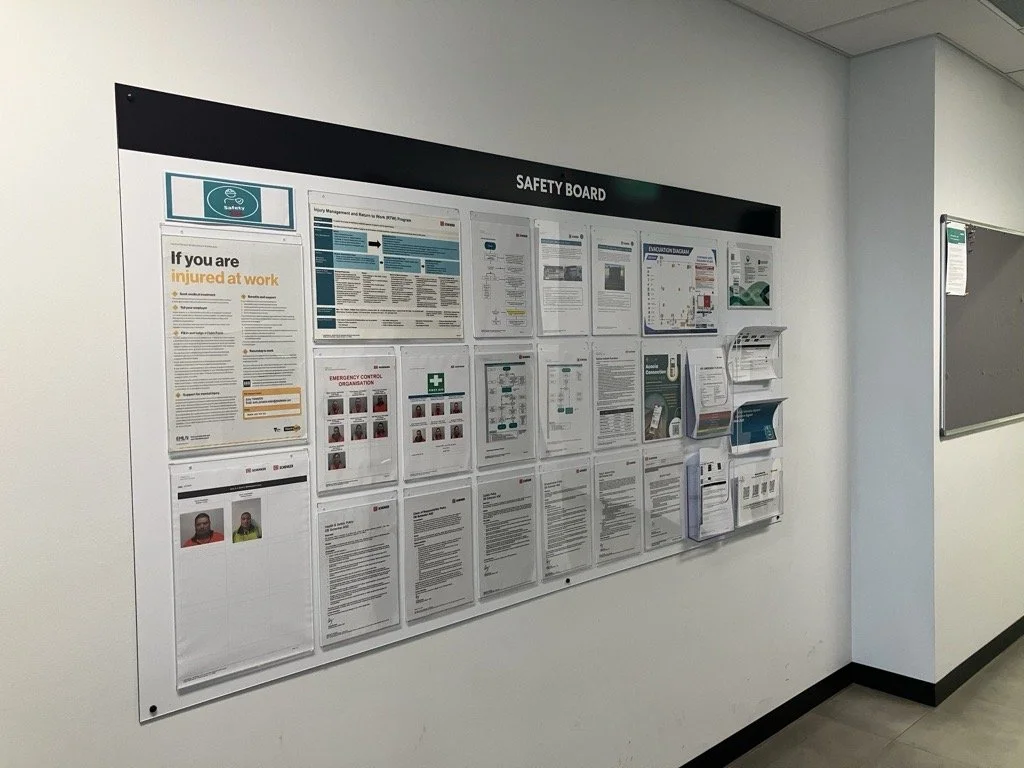Optimising Warehouse Safety Through Effective Use of Safety and First Aid Notice Boards
In the fast-paced world of warehouse and logistics operations, safety is not just a regulatory requirement—it’s a cornerstone of operational efficiency and employee wellbeing. Among the many tools used to promote workplace safety, safety notice boards and first aid notice boards play a vital role in ensuring that critical information is visible, accessible, and actionable.
These boards serve as central hubs for communicating safety protocols, emergency procedures, hazard alerts, and first aid resources. In environments where heavy machinery, high shelving, and constant movement are the norm, having clear, up-to-date safety information can mean the difference between a minor incident and a major workplace injury.
Why Safety Notice Boards Matter
Safety notice boards are designed to keep workers informed about potential hazards, safe work practices, and updates to occupational health and safety (OHS) regulations. They often include:
Site-specific safety rules
Personal protective equipment (PPE) requirements
Emergency evacuation maps
Incident reporting procedures
Contact details for safety officers
In warehouses, where forklifts, pallet jacks, and conveyor belts are in constant use, visibility of safety information is essential. Workers may not always have time to consult manuals or digital systems, but a strategically placed notice board ensures that safety reminders are always within sight.
The Importance of First Aid Notice Boards
First aid notice boards complement safety boards by providing information on how to respond to injuries and medical emergencies. These boards typically display:
Locations of first aid kits and defibrillators
Names and contact details of trained first aid officers
Emergency contact numbers
Basic first aid procedures
In high-risk environments, quick access to first aid information can significantly reduce response time and improve outcomes. For example, knowing the location of a defibrillator during a cardiac emergency can be life-saving.
Case Study: Linfox Logistics
Linfox, one of Australia’s largest logistics companies, has long prioritised safety across its operations. In 2022, the company rolled out a new initiative to standardise safety notice boards across its distribution centres nationwide. Each board was tailored to the site’s specific risks and included QR codes linking to digital safety resources.
Following the rollout, Linfox reported a 15% reduction in minor incidents and a 25% increase in near-miss reporting, indicating that workers were more engaged with safety protocols. The visibility and accessibility of the boards encouraged proactive behaviour and fostered a stronger safety culture.
Case Study: Australia Post Warehousing
Australia Post’s warehousing division faced challenges in maintaining consistent first aid awareness across its facilities. In response, they introduced brightly coloured first aid notice boards with multilingual instructions and visual guides for CPR and wound care.
After implementation, internal audits showed a 30% improvement in first aid response times and a significant increase in staff confidence when dealing with minor injuries. The boards also helped reduce downtime, as workers were able to address issues quickly without waiting for external medical assistance.
Positive Impacts on Operations and Business
The benefits of safety and first aid notice boards extend beyond compliance. Here are several ways they positively impact warehouse and logistics operations:
Improved Safety Culture
When safety information is visible and regularly updated, it reinforces a culture of accountability and care. Workers are more likely to follow procedures and report hazards when they see that safety is taken seriously.Reduced Incidents and Injuries
Clear communication of risks and emergency procedures helps prevent accidents. This leads to fewer workers’ compensation claims and less disruption to operations.Enhanced Operational Efficiency
Quick access to first aid resources and safety protocols minimises downtime during emergencies. Workers can respond swiftly, reducing the impact on productivity.Regulatory Compliance
Notice boards help businesses meet Work Health and Safety (WHS) obligations under Australian law. They serve as evidence of due diligence during audits and inspections.Employee Morale and Retention
A safe workplace is a positive workplace. Employees who feel protected and informed are more likely to stay with the company and contribute to its success.
Best Practices for Implementation
To maximise the effectiveness of safety and first aid notice boards, businesses should:
Keep content current: Regularly update boards with new procedures, contact details, and safety alerts.
Use clear visuals: Include diagrams, icons, and colour coding to aid comprehension.
Ensure accessibility: Place boards in high-traffic areas and ensure they are readable from a distance.
Engage staff: Encourage workers to contribute suggestions and report outdated information.
Integrate with digital systems: Use QR codes or NFC tags to link to online resources and training modules.
Conclusion
In the dynamic and often hazardous environment of warehouse and logistics operations, safety and first aid notice boards are more than just wall fixtures—they are essential tools for protecting workers and streamlining operations. As demonstrated by leading Australian companies like Linfox and Australia Post, investing in clear, accessible safety communication can yield tangible benefits in safety performance, operational efficiency, and employee wellbeing.
By prioritising visibility and engagement, businesses can foster a proactive safety culture that not only meets legal requirements but also drives long-term success.
If you are experiencing any of these challenges and need assistance in implementing an effective warehouse identification system, we are here to help.
Our team of experts specialises in optimising warehouse operations and can provide tailored solutions to address your specific needs. Don't hesitate to reach out to us for guidance and support. Together, we can overcome these challenges and unlock the full potential of your warehouse identification system.
Contact us today to take the first step towards a more efficient and productive warehouse environment.


